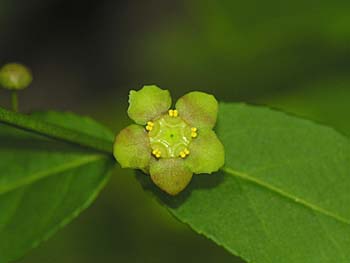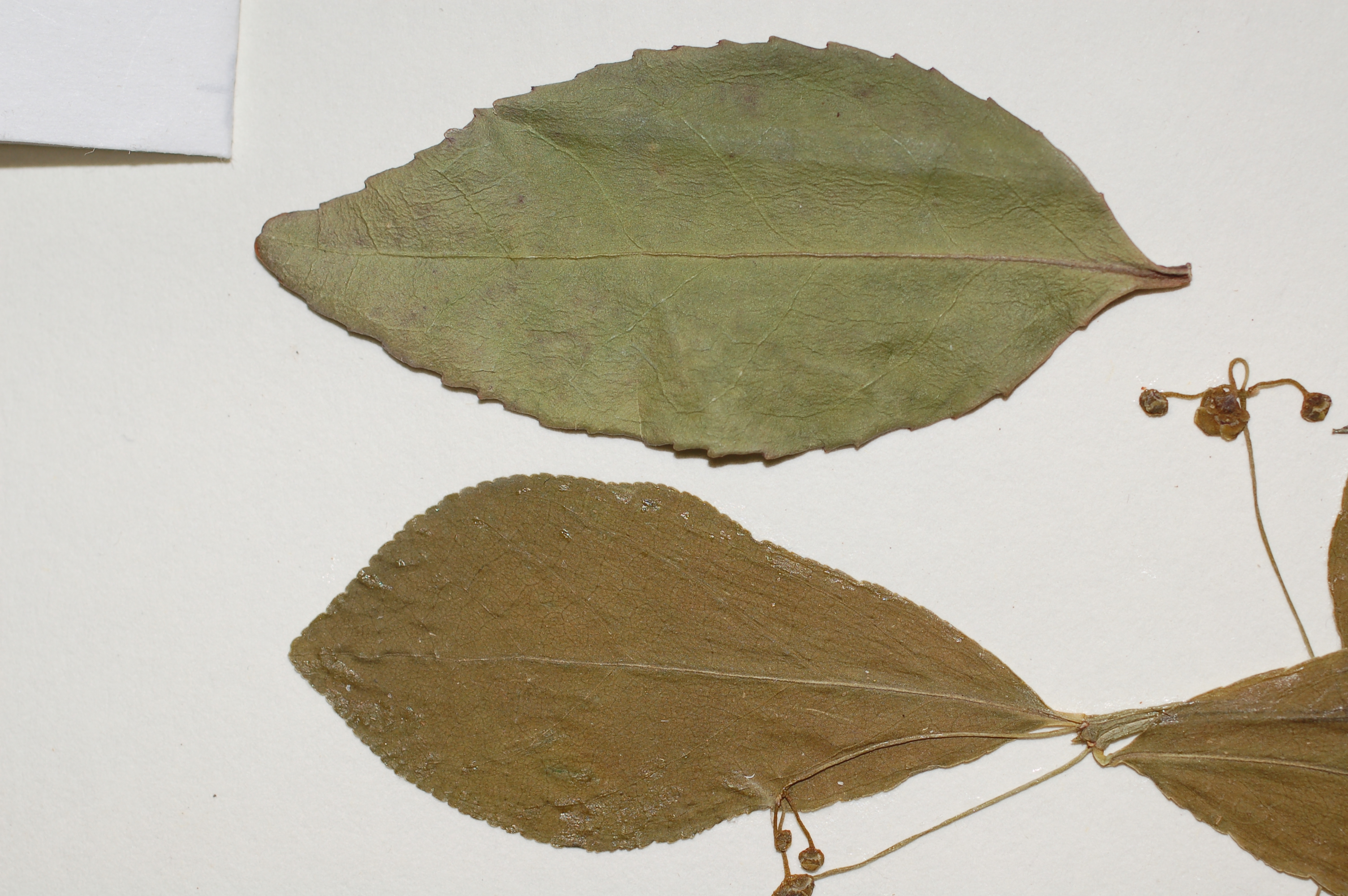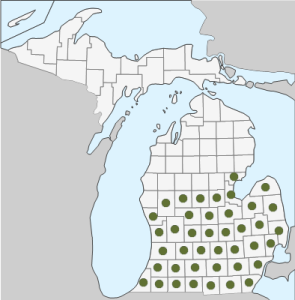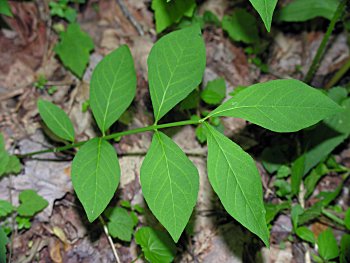 Download PDF
Download PDF
Family: Celastraceae, the Staff-vine Family
Common Names: running strawberry-bush, running euonymus
Etymology: Euonymus is ancient Greek meaning “good name.” Obovatus means obovate, referring to leaf shape (3).
Botanical synonyms: Euonymus obovata Nutt., E. americanus L., E. angustifolius Pursh, E. muricatus Raf., E. sarmentosus (Nutt.) G. Don, E. sempervirens Marshall (7).
Quick Notable Features:
¬ Simple, opposite, serrate, obovate leaves.
¬ Red tuberculate fruit
¬ Prostrate growth form
Plant Height: Branches reach up to 1m high (3, R.J. Burnham pers. obs.).
Subspecies/varieties recognized: None found.
Most Likely Confused with: Often confused with E. americanus. May also be mistaken for E. fortunei, Vinca minor, and low, trailing individuals of Lonicera.
Habitat Preference: The species is found in rich, damp calcareous soils and is shade tolerant. It grows in swamps, woods, thickets, or slopes (1, 3, 9).
Geographic Distribution in Michigan: Prevalent in the southern Lower Peninsula (1).
Known Elevational Distribution: Found in the southern Appalachians of North Carolina, up to 1,200 meters (2).
Complete Geographic Distribution: This native of the eastern United States is found from Georgia to Michigan and New York, and from the eastern coast of the U.S. west to Arkansas and Missouri (2, 5, 11).
Vegetative Plant Description: Low trailing perennial deciduous shrub to prostrate vine, with stems remaining green. Leaves simple, opposite, serrate, obovate to oblong, 3-6cm long, 1.3-3.8cm wide. The leaves are glabrous, thin, opaque, obtuse, with petioles .2 to .4cm long, unlike the one similar species, E. americanus (14). Branchlets are 4-sided, growing 30-60cm high (3, 4, 9).
Climbing Mechanism: Sprawler with stems commonly rooting (11, pers. obs. Susu Yuan, 2006).
 Flower Description: Flowers are greenish-purple, small, perfect, borne on axillary pedunculate cymes of 2-5. Flowers are 5-merous, 6-8mm in diameter. Sepals are short and flat, uniting at the base. Petals are rounded and broadly spreading. Stamens are short; style short or absent. Stamens borne on a flat disk attached to the calyx. The superior ovary is largely immersed in the disk. Ovary and stigma are 5-lobed (3, 4, 5, 14).
Flower Description: Flowers are greenish-purple, small, perfect, borne on axillary pedunculate cymes of 2-5. Flowers are 5-merous, 6-8mm in diameter. Sepals are short and flat, uniting at the base. Petals are rounded and broadly spreading. Stamens are short; style short or absent. Stamens borne on a flat disk attached to the calyx. The superior ovary is largely immersed in the disk. Ovary and stigma are 5-lobed (3, 4, 5, 14).
Flowering Time: Late spring (May and June) in Northeastern U.S. (3).
Pollinator: Bee and fly pollinated (9).
 Fruit Type and Description: The fruit is a 1.5cm wide leathery, tuberculate, 3-lobed capsule that is red when ripe. Each locule has 1-4 seeds; seeds are covered in a fleshy red aril (5).
Fruit Type and Description: The fruit is a 1.5cm wide leathery, tuberculate, 3-lobed capsule that is red when ripe. Each locule has 1-4 seeds; seeds are covered in a fleshy red aril (5).
Seed Description: Seeds are completely covered in fleshy red aril (5).
Dispersal Syndrome (and evidence): Bird dispersed, August thru October (8).
Distinguished by: In Michigan this species is commonly misidentified as a southern species E. americanus (1). E. obovatus and E. americanus share the same general habit. E. obovatus has obtuse and petioled leaves and 3-lobed capsules whereas leaves of E. americanus are nearly sessile and the fruits are sometimes 5-lobed (3, 12). E. americanus has not been reported in Michigan, but its range extends to Ohio and Indiana (2).
 E. fortunei is a widely cultivated evergreen shrub to woody vine; the specific form varies greatly depending on cultivar (3, 14). Its leaves are elliptical, coriaceous, and have strong whitish venation beneath; E. obovatus leaves are obovate, thin, and have veins that are more or less the same color as the leaf lamina and much less apparent. E. fortunei fruits are smooth and globose while E. obovatus fruits strongly tuberculate (3, 11).
E. fortunei is a widely cultivated evergreen shrub to woody vine; the specific form varies greatly depending on cultivar (3, 14). Its leaves are elliptical, coriaceous, and have strong whitish venation beneath; E. obovatus leaves are obovate, thin, and have veins that are more or less the same color as the leaf lamina and much less apparent. E. fortunei fruits are smooth and globose while E. obovatus fruits strongly tuberculate (3, 11).
Vinca minor may resemble E. obovatus in general habit. However, V. minor leaves are entire, sometimes occur in whorls of four, and the plants bear abundant white stem latex.
E. obovatus may resemble low, trailing individuals of the genus Lonicera. However, Lonicera spp. leaves are entire while E. obovatus leaves are finely serrate (12).
Other members of the family in Michigan: Celastrus (2), Euonymus (4).
Ethnobotanical Uses: Decoction of plants taken to clear circulatory or urinary tracts. Also used as a counter to witchcraft (10).
 Phylogenetic Information: Families Celastraceae and Lepidobotryaceae belong in the order Celastrales. Celastrales belong in the Eurosids I. They form a monophyletic group with the Malpighiales and Oxidales and are Eudicots. Celastrales are angiosperms (6).
Phylogenetic Information: Families Celastraceae and Lepidobotryaceae belong in the order Celastrales. Celastrales belong in the Eurosids I. They form a monophyletic group with the Malpighiales and Oxidales and are Eudicots. Celastrales are angiosperms (6).
Interesting Quotation or Other Interesting Factoid not inserted above: The name Euonymus is ironic due to the genus’ notoriety for poisoning cattle (3).
Literature and websites used:
- Voss, E. G. 1985. Michigan Flora Part II. Cranbrook Institute: Ann Arbor, MI
- USDA PLANTS Profile database. http://plants.usda.gov/java/profile?symbol=EUOB8
- Fernald, M. L. 1950. Gray’s Manual of Botany, 8th edition. New York: American Book Co.
- Hitchcock, C. L. and A. Cronquist. 1973. Flora of the Pacific Northwest. University of Washington Press: Seattle.
- Gleason, H. A. 1963. Illustrated Flora of the Northeastern United States and Adjacent Canada, Volume 2. New York: Hafner Publishing Company, Inc.
- APG II 2003. An update of the Angiosperm Phylogeny Group classification for the orders and families of flowering plants: APG II. Botanical Journal Linnean Society 141(4):399-436.
- Wunderlin, R. and B. Hansen. 2006. Atlas of Florida Vascular Plants. University of South Florida Institute for Systematic Botany. http://www.plantatlas.usf.edu/synonyms.asp?plantID=3407
- Stiles, E.W. 1979. Patterns of fruit presentation and seed dispersal in bird-disseminated woody plants in the eastern deciduous forest. The American Naturalist. 116(5): 670-88.
- Iverson, L., D. Ketzner, and J. Karnes. Euonymus obovatus. Illinois Plant Information Network. http://www.fs.fed.us/ne/delaware/ilpin/1264.co
- Moerman, D. 2006. Native American Ethnobotany. University of Michigan – Dearborn. http://herb.umd.umich.edu/
- Cooperrider, T.S. 1995. The Dicotyledons of Ohio – Part 2. Linaceae through Campanulaceae. Columbus: Ohio State University Press.
- Gleason, A. and A. Cronquist. 1991. Manual of Vascular Plants of Northeastern United States and Adjacent Canada. New York: New York Botanical Garden.
- Seiler, J. R., E. C. Jensen, & J. A. Peterson. 2006. Euonymus fortunei Fact Sheet. Virginia Tech Forestry Dept. http://www.cnr.vt.edu/dendro/dendrology/Syllabus2/factsheet.cfm?ID=504
- Britton, N.L. & H.A. Brown 1970. An Illustrated Flora of the Northern United States and Canada: Volume II. New York, NY: Dover Publications, Inc.
Image credits (all used with permission):
1, 2) Images of habit and flower copyright Will Cook, Trees, Shrubs, and Woody Vines of North Carolina. Duke University. http://www.duke.edu/~cwcook/trees/euob.html
3) Image of fruit © Greg Vaclavek and the University of Wisconsin – Stevens Point.
4) Dried leaf image by Robyn J. Burnham, University of Michigan, Ann Arbor, MI.
5) Species distribution map, derived from the Michigan Flora Online.
Primary Authors: Susu Yuan and John Bradtke, with editing by Robyn Burnham and Cristine V, Santanna.
© Robyn J. Burnham, 2013
For additional information on Michigan Plant Diversity web pages please contact Robyn J. Burnham via email: rburnham“at”umich.edu
